Accounting for Managers Report: Platform LLP Financial Analysis
VerifiedAdded on 2019/11/19
|13
|2946
|159
Report
AI Summary
This report provides a comprehensive analysis of accounting for managers, focusing on a retail clothing startup named "Platform" in Dubai, structured as a Limited Liability Partnership (LLP). The report begins with a business description, followed by a justification for selecting the LLP structure, highlighting its advantages in terms of maintenance, liability protection, and taxation. It then explores various financing options available, including equity financing, debentures, and bank loans, and presents projected financial statements, including income statements and balance sheets for the years 2016-2018. The report further analyzes the types of financial statement analysis relevant to the business, such as income statements, balance sheets, and cash flow statements. It also discusses how accounting information aids in management accounting for partners and employees, and financial accounting for investors, banks, regulatory authorities, and customers. Finally, the report examines the benefits of dividend distribution and the implications of not distributing dividends, particularly for employees and the potential for government intervention.
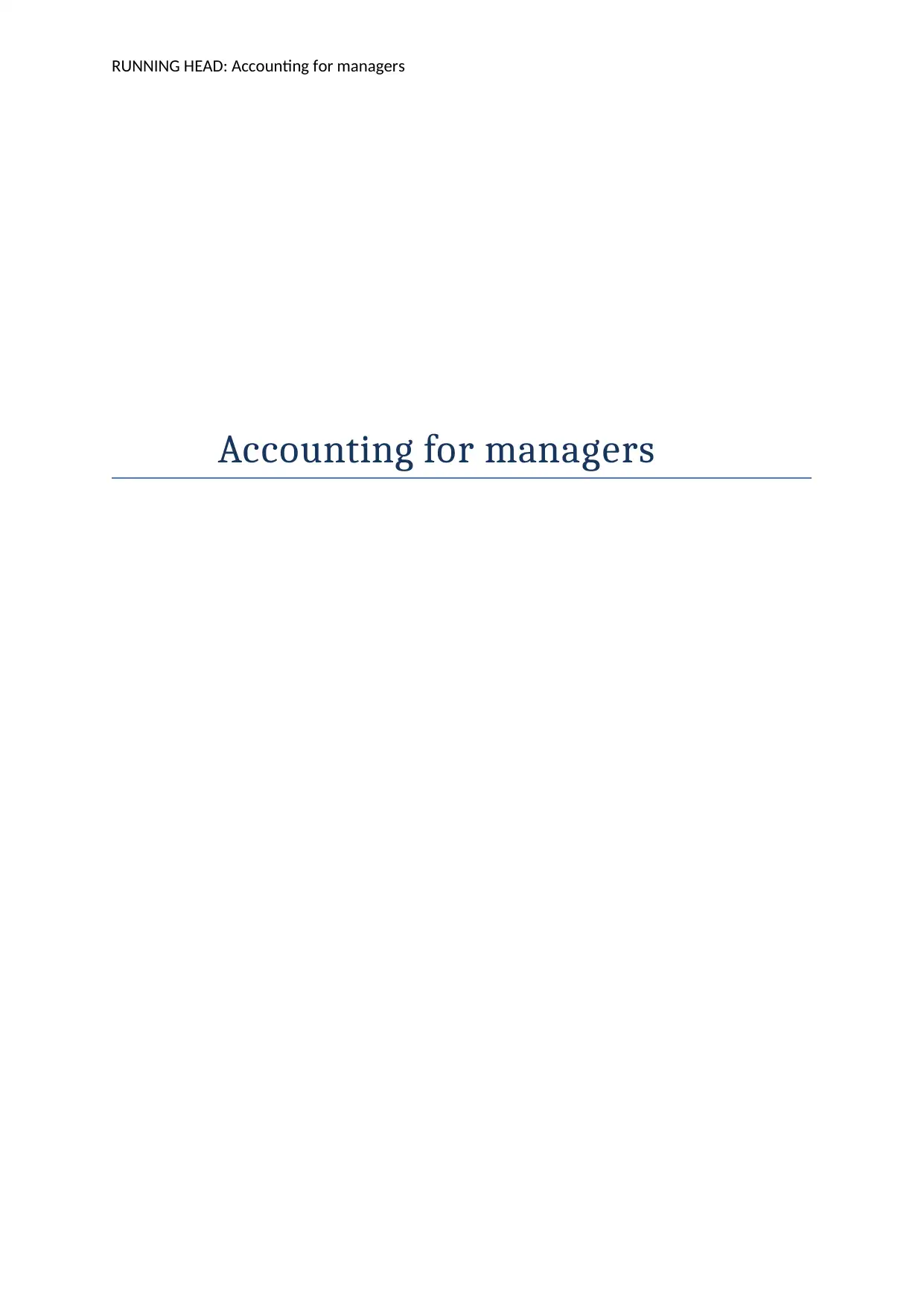
RUNNING HEAD: Accounting for managers
Accounting for managers
Accounting for managers
Paraphrase This Document
Need a fresh take? Get an instant paraphrase of this document with our AI Paraphraser
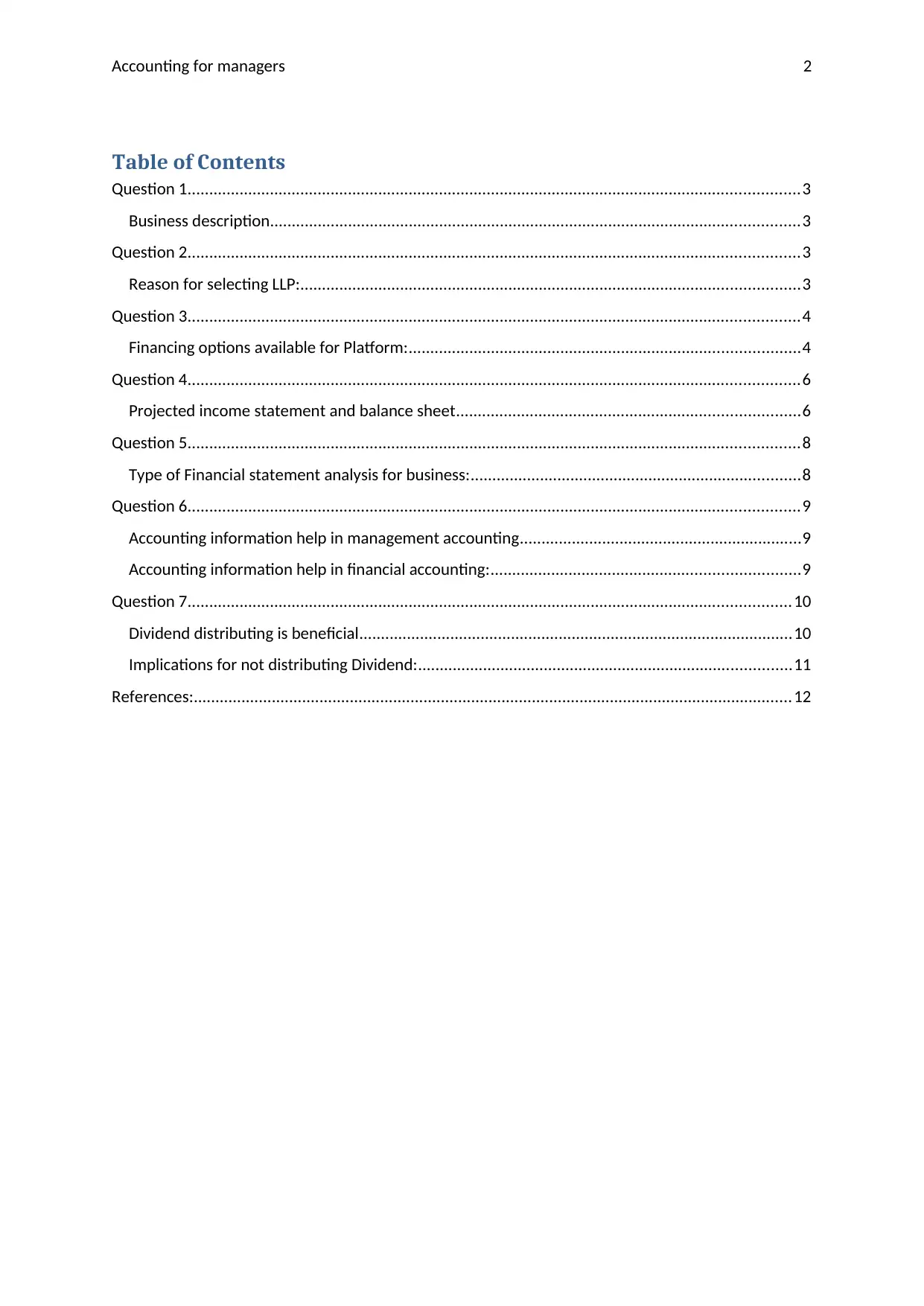
Accounting for managers 2
Table of Contents
Question 1.............................................................................................................................................3
Business description..........................................................................................................................3
Question 2.............................................................................................................................................3
Reason for selecting LLP:...................................................................................................................3
Question 3.............................................................................................................................................4
Financing options available for Platform:..........................................................................................4
Question 4.............................................................................................................................................6
Projected income statement and balance sheet...............................................................................6
Question 5.............................................................................................................................................8
Type of Financial statement analysis for business:............................................................................8
Question 6.............................................................................................................................................9
Accounting information help in management accounting.................................................................9
Accounting information help in financial accounting:.......................................................................9
Question 7...........................................................................................................................................10
Dividend distributing is beneficial....................................................................................................10
Implications for not distributing Dividend:......................................................................................11
References:..........................................................................................................................................12
Table of Contents
Question 1.............................................................................................................................................3
Business description..........................................................................................................................3
Question 2.............................................................................................................................................3
Reason for selecting LLP:...................................................................................................................3
Question 3.............................................................................................................................................4
Financing options available for Platform:..........................................................................................4
Question 4.............................................................................................................................................6
Projected income statement and balance sheet...............................................................................6
Question 5.............................................................................................................................................8
Type of Financial statement analysis for business:............................................................................8
Question 6.............................................................................................................................................9
Accounting information help in management accounting.................................................................9
Accounting information help in financial accounting:.......................................................................9
Question 7...........................................................................................................................................10
Dividend distributing is beneficial....................................................................................................10
Implications for not distributing Dividend:......................................................................................11
References:..........................................................................................................................................12
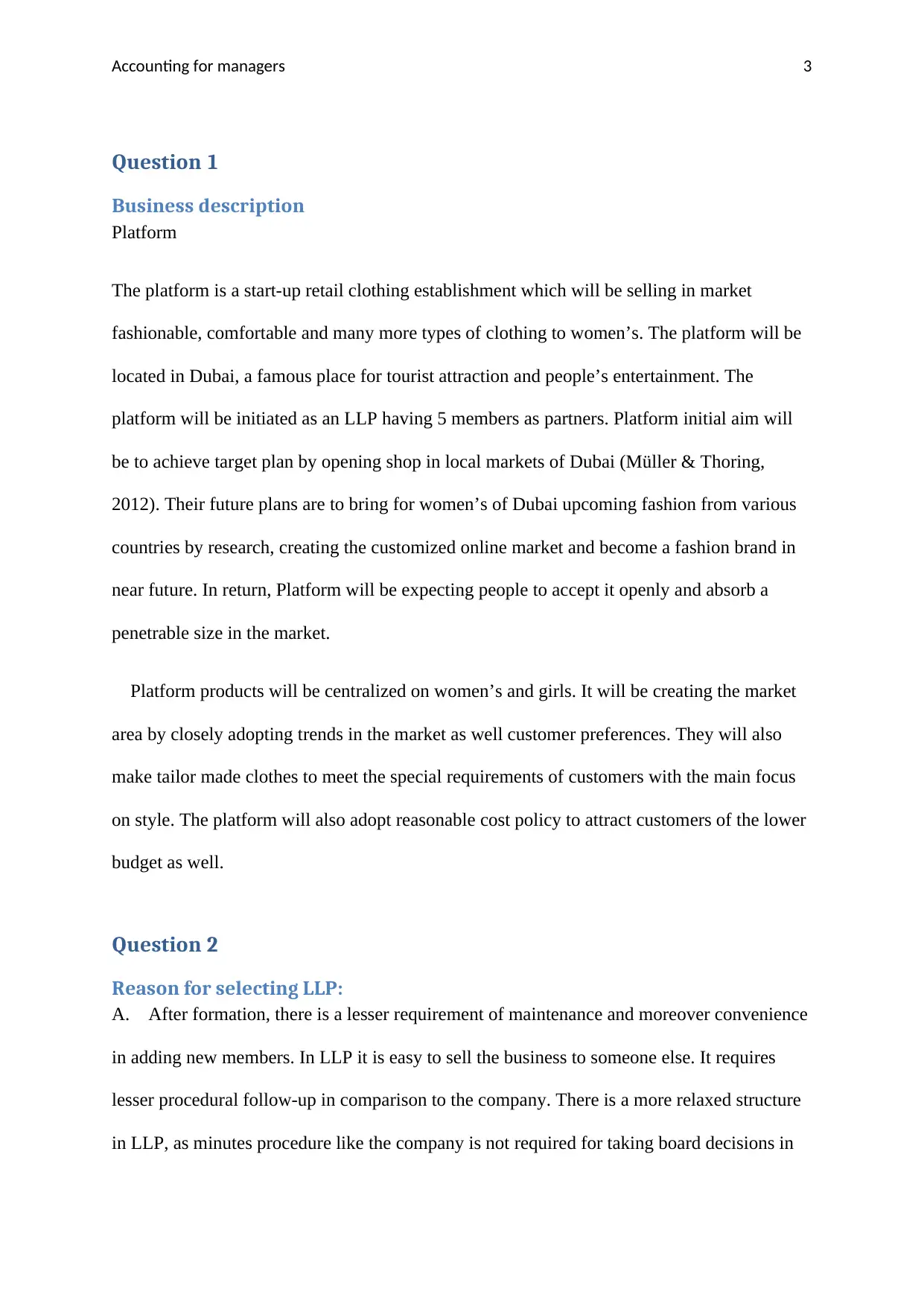
Accounting for managers 3
Question 1
Business description
Platform
The platform is a start-up retail clothing establishment which will be selling in market
fashionable, comfortable and many more types of clothing to women’s. The platform will be
located in Dubai, a famous place for tourist attraction and people’s entertainment. The
platform will be initiated as an LLP having 5 members as partners. Platform initial aim will
be to achieve target plan by opening shop in local markets of Dubai (Müller & Thoring,
2012). Their future plans are to bring for women’s of Dubai upcoming fashion from various
countries by research, creating the customized online market and become a fashion brand in
near future. In return, Platform will be expecting people to accept it openly and absorb a
penetrable size in the market.
Platform products will be centralized on women’s and girls. It will be creating the market
area by closely adopting trends in the market as well customer preferences. They will also
make tailor made clothes to meet the special requirements of customers with the main focus
on style. The platform will also adopt reasonable cost policy to attract customers of the lower
budget as well.
Question 2
Reason for selecting LLP:
A. After formation, there is a lesser requirement of maintenance and moreover convenience
in adding new members. In LLP it is easy to sell the business to someone else. It requires
lesser procedural follow-up in comparison to the company. There is a more relaxed structure
in LLP, as minutes procedure like the company is not required for taking board decisions in
Question 1
Business description
Platform
The platform is a start-up retail clothing establishment which will be selling in market
fashionable, comfortable and many more types of clothing to women’s. The platform will be
located in Dubai, a famous place for tourist attraction and people’s entertainment. The
platform will be initiated as an LLP having 5 members as partners. Platform initial aim will
be to achieve target plan by opening shop in local markets of Dubai (Müller & Thoring,
2012). Their future plans are to bring for women’s of Dubai upcoming fashion from various
countries by research, creating the customized online market and become a fashion brand in
near future. In return, Platform will be expecting people to accept it openly and absorb a
penetrable size in the market.
Platform products will be centralized on women’s and girls. It will be creating the market
area by closely adopting trends in the market as well customer preferences. They will also
make tailor made clothes to meet the special requirements of customers with the main focus
on style. The platform will also adopt reasonable cost policy to attract customers of the lower
budget as well.
Question 2
Reason for selecting LLP:
A. After formation, there is a lesser requirement of maintenance and moreover convenience
in adding new members. In LLP it is easy to sell the business to someone else. It requires
lesser procedural follow-up in comparison to the company. There is a more relaxed structure
in LLP, as minutes procedure like the company is not required for taking board decisions in
⊘ This is a preview!⊘
Do you want full access?
Subscribe today to unlock all pages.

Trusted by 1+ million students worldwide
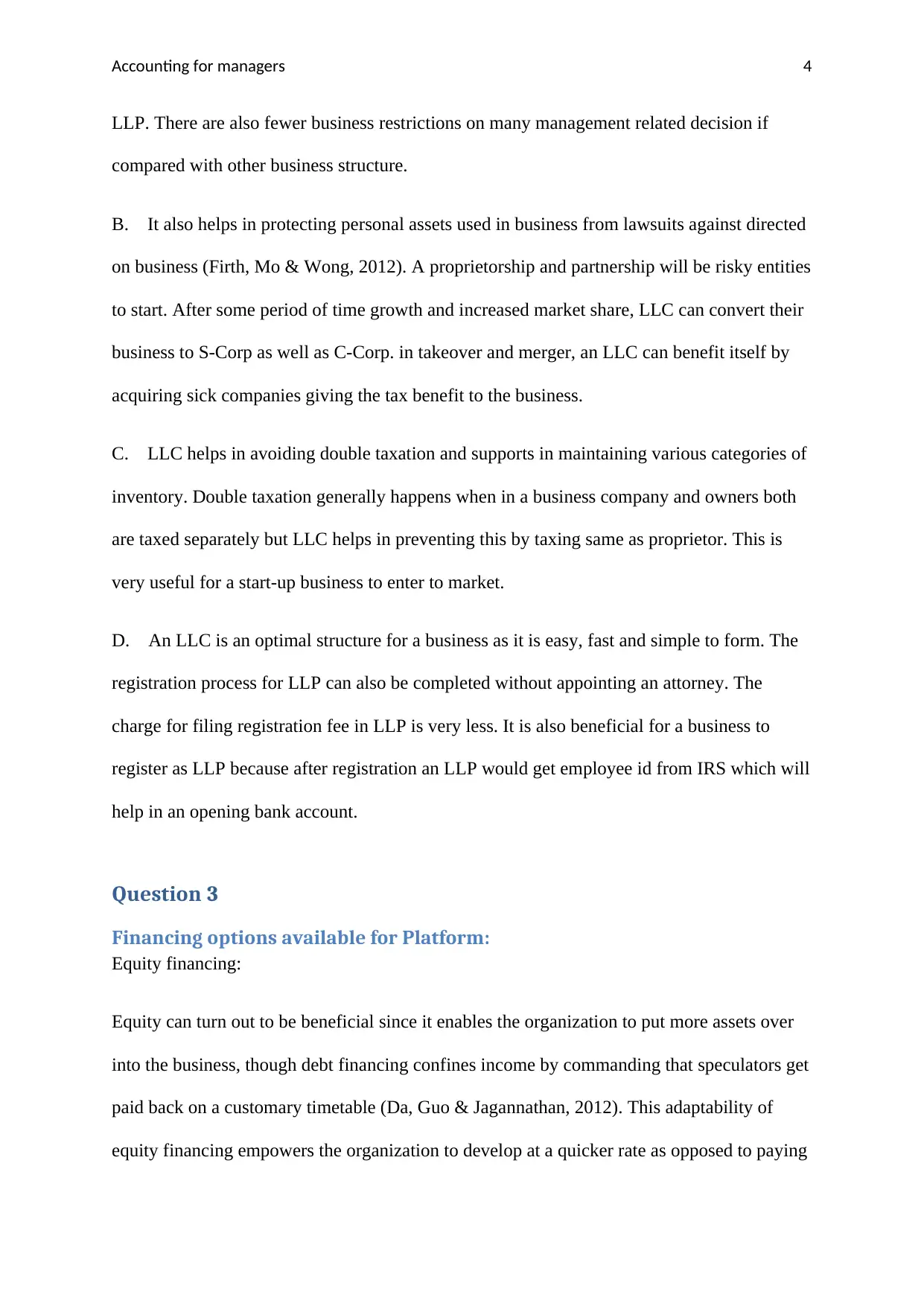
Accounting for managers 4
LLP. There are also fewer business restrictions on many management related decision if
compared with other business structure.
B. It also helps in protecting personal assets used in business from lawsuits against directed
on business (Firth, Mo & Wong, 2012). A proprietorship and partnership will be risky entities
to start. After some period of time growth and increased market share, LLC can convert their
business to S-Corp as well as C-Corp. in takeover and merger, an LLC can benefit itself by
acquiring sick companies giving the tax benefit to the business.
C. LLC helps in avoiding double taxation and supports in maintaining various categories of
inventory. Double taxation generally happens when in a business company and owners both
are taxed separately but LLC helps in preventing this by taxing same as proprietor. This is
very useful for a start-up business to enter to market.
D. An LLC is an optimal structure for a business as it is easy, fast and simple to form. The
registration process for LLP can also be completed without appointing an attorney. The
charge for filing registration fee in LLP is very less. It is also beneficial for a business to
register as LLP because after registration an LLP would get employee id from IRS which will
help in an opening bank account.
Question 3
Financing options available for Platform:
Equity financing:
Equity can turn out to be beneficial since it enables the organization to put more assets over
into the business, though debt financing confines income by commanding that speculators get
paid back on a customary timetable (Da, Guo & Jagannathan, 2012). This adaptability of
equity financing empowers the organization to develop at a quicker rate as opposed to paying
LLP. There are also fewer business restrictions on many management related decision if
compared with other business structure.
B. It also helps in protecting personal assets used in business from lawsuits against directed
on business (Firth, Mo & Wong, 2012). A proprietorship and partnership will be risky entities
to start. After some period of time growth and increased market share, LLC can convert their
business to S-Corp as well as C-Corp. in takeover and merger, an LLC can benefit itself by
acquiring sick companies giving the tax benefit to the business.
C. LLC helps in avoiding double taxation and supports in maintaining various categories of
inventory. Double taxation generally happens when in a business company and owners both
are taxed separately but LLC helps in preventing this by taxing same as proprietor. This is
very useful for a start-up business to enter to market.
D. An LLC is an optimal structure for a business as it is easy, fast and simple to form. The
registration process for LLP can also be completed without appointing an attorney. The
charge for filing registration fee in LLP is very less. It is also beneficial for a business to
register as LLP because after registration an LLP would get employee id from IRS which will
help in an opening bank account.
Question 3
Financing options available for Platform:
Equity financing:
Equity can turn out to be beneficial since it enables the organization to put more assets over
into the business, though debt financing confines income by commanding that speculators get
paid back on a customary timetable (Da, Guo & Jagannathan, 2012). This adaptability of
equity financing empowers the organization to develop at a quicker rate as opposed to paying
Paraphrase This Document
Need a fresh take? Get an instant paraphrase of this document with our AI Paraphraser
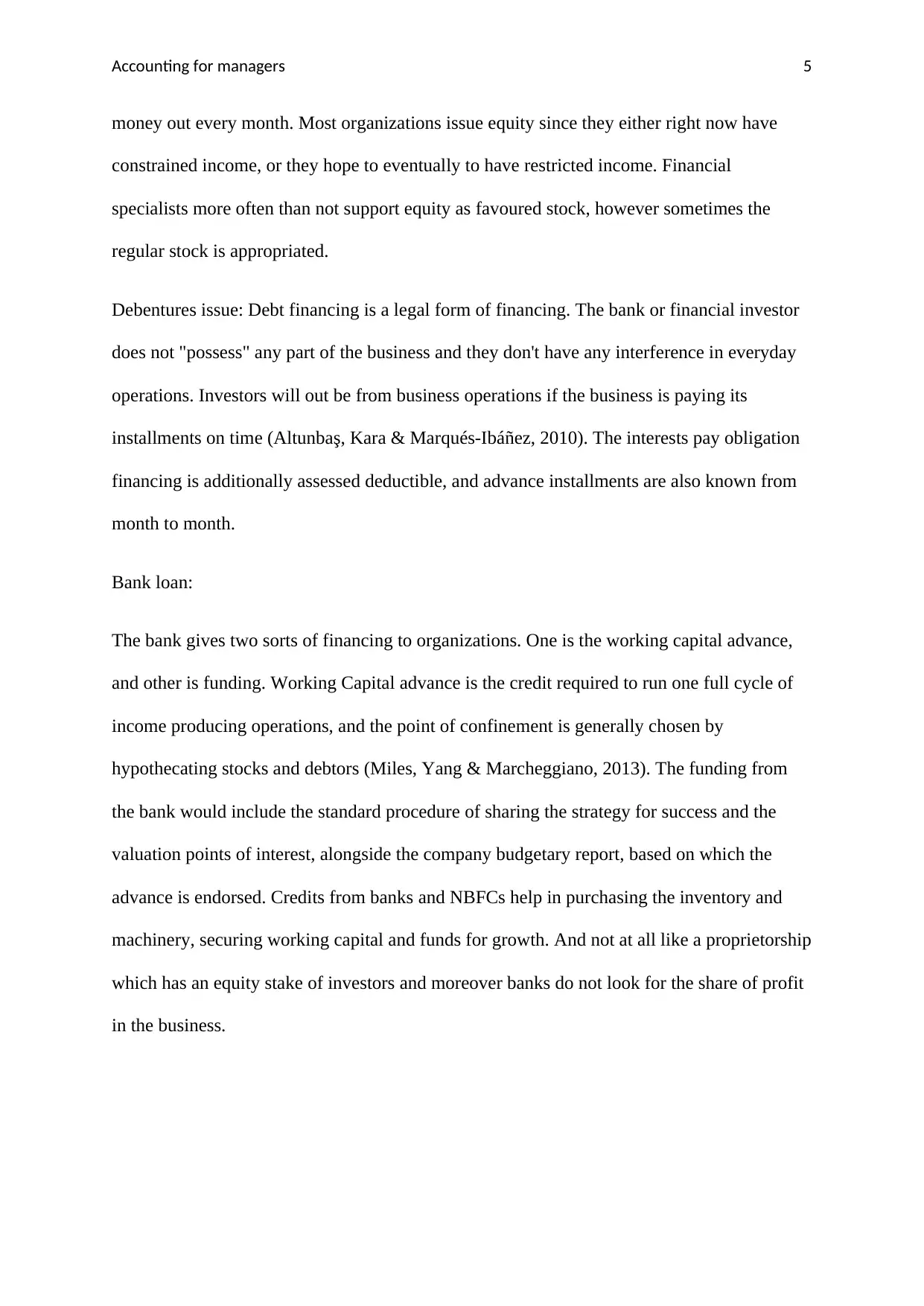
Accounting for managers 5
money out every month. Most organizations issue equity since they either right now have
constrained income, or they hope to eventually to have restricted income. Financial
specialists more often than not support equity as favoured stock, however sometimes the
regular stock is appropriated.
Debentures issue: Debt financing is a legal form of financing. The bank or financial investor
does not "possess" any part of the business and they don't have any interference in everyday
operations. Investors will out be from business operations if the business is paying its
installments on time (Altunbaş, Kara & Marqués-Ibáñez, 2010). The interests pay obligation
financing is additionally assessed deductible, and advance installments are also known from
month to month.
Bank loan:
The bank gives two sorts of financing to organizations. One is the working capital advance,
and other is funding. Working Capital advance is the credit required to run one full cycle of
income producing operations, and the point of confinement is generally chosen by
hypothecating stocks and debtors (Miles, Yang & Marcheggiano, 2013). The funding from
the bank would include the standard procedure of sharing the strategy for success and the
valuation points of interest, alongside the company budgetary report, based on which the
advance is endorsed. Credits from banks and NBFCs help in purchasing the inventory and
machinery, securing working capital and funds for growth. And not at all like a proprietorship
which has an equity stake of investors and moreover banks do not look for the share of profit
in the business.
money out every month. Most organizations issue equity since they either right now have
constrained income, or they hope to eventually to have restricted income. Financial
specialists more often than not support equity as favoured stock, however sometimes the
regular stock is appropriated.
Debentures issue: Debt financing is a legal form of financing. The bank or financial investor
does not "possess" any part of the business and they don't have any interference in everyday
operations. Investors will out be from business operations if the business is paying its
installments on time (Altunbaş, Kara & Marqués-Ibáñez, 2010). The interests pay obligation
financing is additionally assessed deductible, and advance installments are also known from
month to month.
Bank loan:
The bank gives two sorts of financing to organizations. One is the working capital advance,
and other is funding. Working Capital advance is the credit required to run one full cycle of
income producing operations, and the point of confinement is generally chosen by
hypothecating stocks and debtors (Miles, Yang & Marcheggiano, 2013). The funding from
the bank would include the standard procedure of sharing the strategy for success and the
valuation points of interest, alongside the company budgetary report, based on which the
advance is endorsed. Credits from banks and NBFCs help in purchasing the inventory and
machinery, securing working capital and funds for growth. And not at all like a proprietorship
which has an equity stake of investors and moreover banks do not look for the share of profit
in the business.
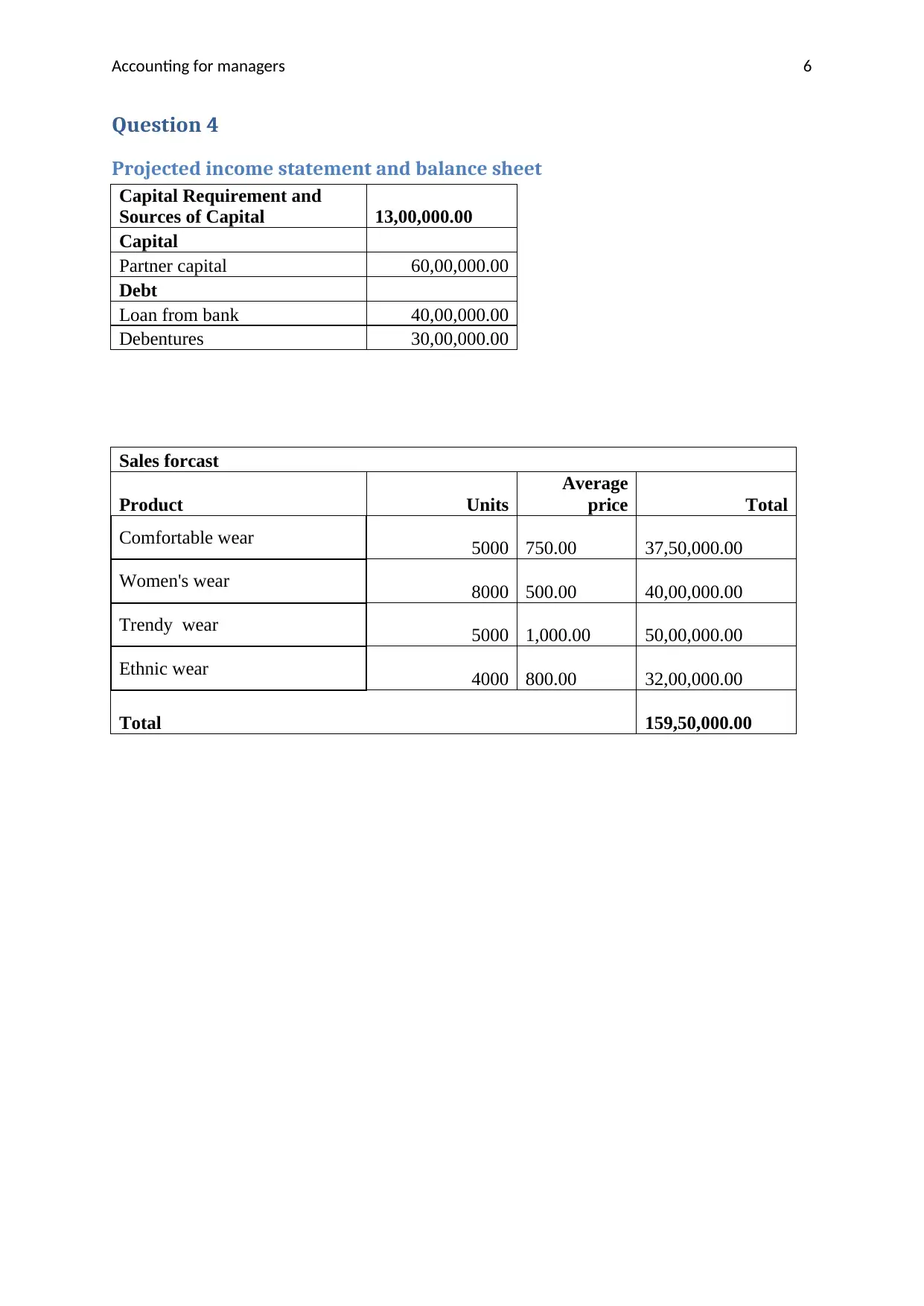
Accounting for managers 6
Question 4
Projected income statement and balance sheet
Capital Requirement and
Sources of Capital 13,00,000.00
Capital
Partner capital 60,00,000.00
Debt
Loan from bank 40,00,000.00
Debentures 30,00,000.00
Sales forcast
Product Units
Average
price Total
Comfortable wear 5000 750.00 37,50,000.00
Women's wear 8000 500.00 40,00,000.00
Trendy wear 5000 1,000.00 50,00,000.00
Ethnic wear 4000 800.00 32,00,000.00
Total 159,50,000.00
Question 4
Projected income statement and balance sheet
Capital Requirement and
Sources of Capital 13,00,000.00
Capital
Partner capital 60,00,000.00
Debt
Loan from bank 40,00,000.00
Debentures 30,00,000.00
Sales forcast
Product Units
Average
price Total
Comfortable wear 5000 750.00 37,50,000.00
Women's wear 8000 500.00 40,00,000.00
Trendy wear 5000 1,000.00 50,00,000.00
Ethnic wear 4000 800.00 32,00,000.00
Total 159,50,000.00
⊘ This is a preview!⊘
Do you want full access?
Subscribe today to unlock all pages.

Trusted by 1+ million students worldwide
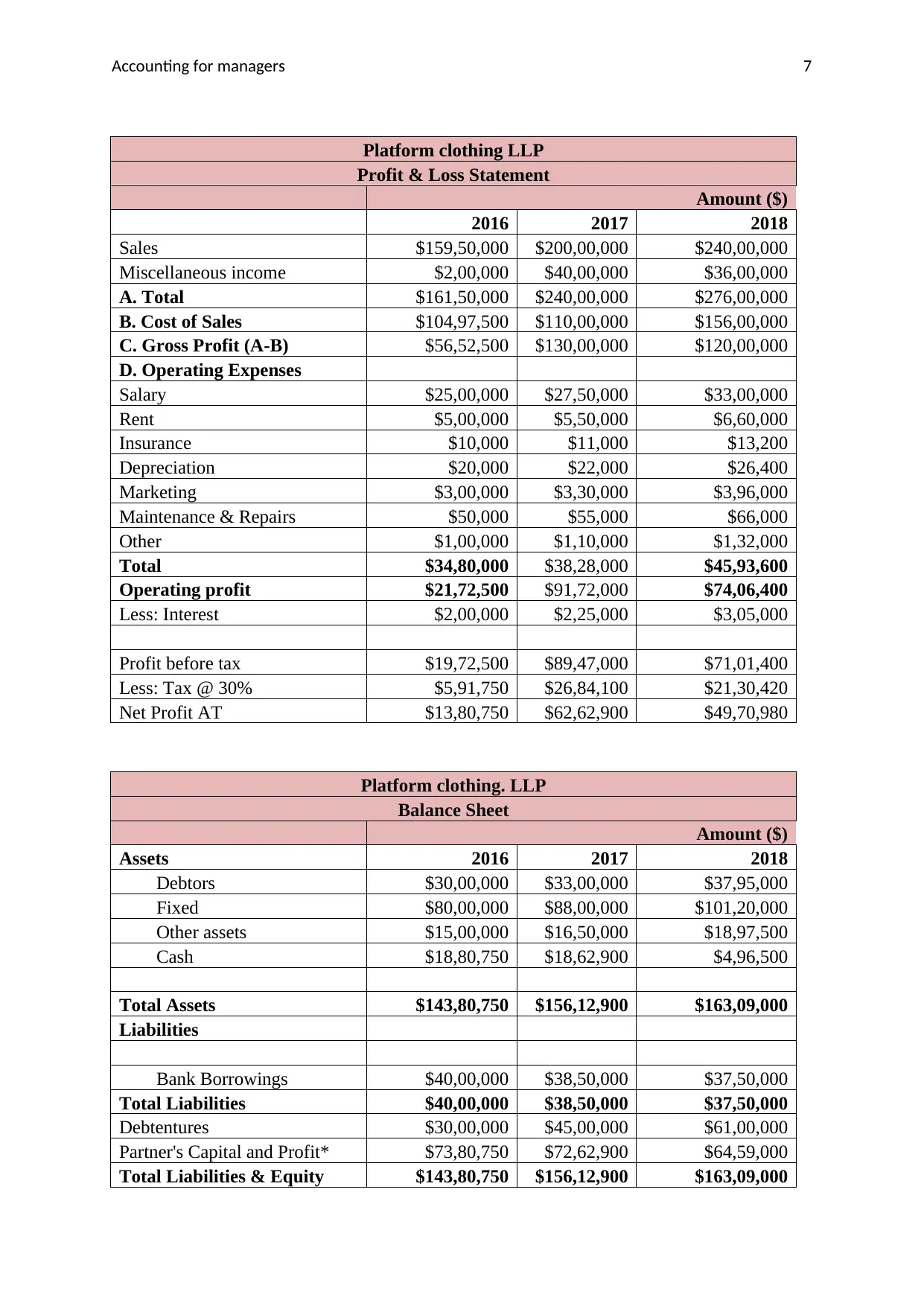
Accounting for managers 7
Platform clothing LLP
Profit & Loss Statement
Amount ($)
2016 2017 2018
Sales $159,50,000 $200,00,000 $240,00,000
Miscellaneous income $2,00,000 $40,00,000 $36,00,000
A. Total $161,50,000 $240,00,000 $276,00,000
B. Cost of Sales $104,97,500 $110,00,000 $156,00,000
C. Gross Profit (A-B) $56,52,500 $130,00,000 $120,00,000
D. Operating Expenses
Salary $25,00,000 $27,50,000 $33,00,000
Rent $5,00,000 $5,50,000 $6,60,000
Insurance $10,000 $11,000 $13,200
Depreciation $20,000 $22,000 $26,400
Marketing $3,00,000 $3,30,000 $3,96,000
Maintenance & Repairs $50,000 $55,000 $66,000
Other $1,00,000 $1,10,000 $1,32,000
Total $34,80,000 $38,28,000 $45,93,600
Operating profit $21,72,500 $91,72,000 $74,06,400
Less: Interest $2,00,000 $2,25,000 $3,05,000
Profit before tax $19,72,500 $89,47,000 $71,01,400
Less: Tax @ 30% $5,91,750 $26,84,100 $21,30,420
Net Profit AT $13,80,750 $62,62,900 $49,70,980
Platform clothing. LLP
Balance Sheet
Amount ($)
Assets 2016 2017 2018
Debtors $30,00,000 $33,00,000 $37,95,000
Fixed $80,00,000 $88,00,000 $101,20,000
Other assets $15,00,000 $16,50,000 $18,97,500
Cash $18,80,750 $18,62,900 $4,96,500
Total Assets $143,80,750 $156,12,900 $163,09,000
Liabilities
Bank Borrowings $40,00,000 $38,50,000 $37,50,000
Total Liabilities $40,00,000 $38,50,000 $37,50,000
Debtentures $30,00,000 $45,00,000 $61,00,000
Partner's Capital and Profit* $73,80,750 $72,62,900 $64,59,000
Total Liabilities & Equity $143,80,750 $156,12,900 $163,09,000
Platform clothing LLP
Profit & Loss Statement
Amount ($)
2016 2017 2018
Sales $159,50,000 $200,00,000 $240,00,000
Miscellaneous income $2,00,000 $40,00,000 $36,00,000
A. Total $161,50,000 $240,00,000 $276,00,000
B. Cost of Sales $104,97,500 $110,00,000 $156,00,000
C. Gross Profit (A-B) $56,52,500 $130,00,000 $120,00,000
D. Operating Expenses
Salary $25,00,000 $27,50,000 $33,00,000
Rent $5,00,000 $5,50,000 $6,60,000
Insurance $10,000 $11,000 $13,200
Depreciation $20,000 $22,000 $26,400
Marketing $3,00,000 $3,30,000 $3,96,000
Maintenance & Repairs $50,000 $55,000 $66,000
Other $1,00,000 $1,10,000 $1,32,000
Total $34,80,000 $38,28,000 $45,93,600
Operating profit $21,72,500 $91,72,000 $74,06,400
Less: Interest $2,00,000 $2,25,000 $3,05,000
Profit before tax $19,72,500 $89,47,000 $71,01,400
Less: Tax @ 30% $5,91,750 $26,84,100 $21,30,420
Net Profit AT $13,80,750 $62,62,900 $49,70,980
Platform clothing. LLP
Balance Sheet
Amount ($)
Assets 2016 2017 2018
Debtors $30,00,000 $33,00,000 $37,95,000
Fixed $80,00,000 $88,00,000 $101,20,000
Other assets $15,00,000 $16,50,000 $18,97,500
Cash $18,80,750 $18,62,900 $4,96,500
Total Assets $143,80,750 $156,12,900 $163,09,000
Liabilities
Bank Borrowings $40,00,000 $38,50,000 $37,50,000
Total Liabilities $40,00,000 $38,50,000 $37,50,000
Debtentures $30,00,000 $45,00,000 $61,00,000
Partner's Capital and Profit* $73,80,750 $72,62,900 $64,59,000
Total Liabilities & Equity $143,80,750 $156,12,900 $163,09,000
Paraphrase This Document
Need a fresh take? Get an instant paraphrase of this document with our AI Paraphraser
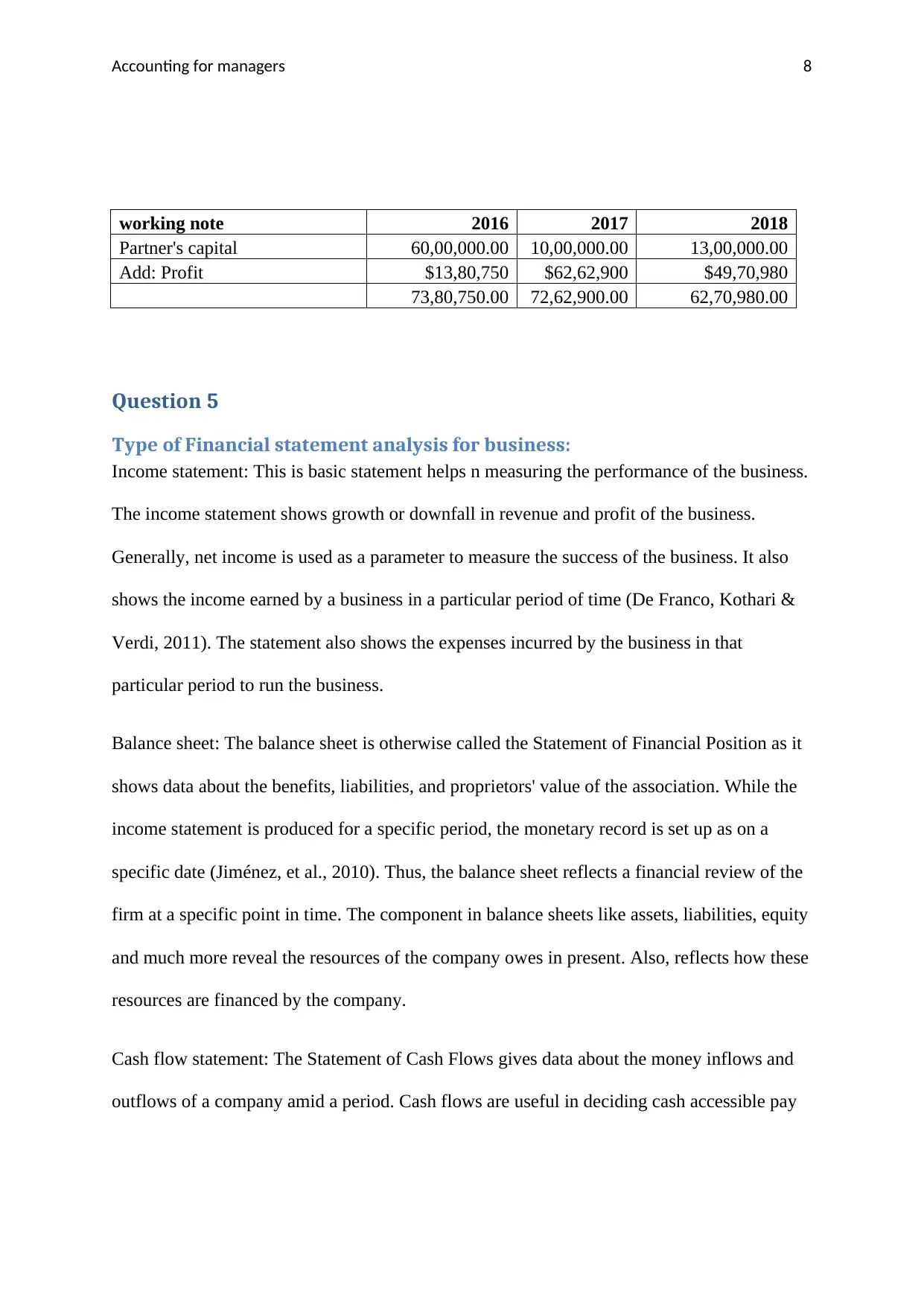
Accounting for managers 8
working note 2016 2017 2018
Partner's capital 60,00,000.00 10,00,000.00 13,00,000.00
Add: Profit $13,80,750 $62,62,900 $49,70,980
73,80,750.00 72,62,900.00 62,70,980.00
Question 5
Type of Financial statement analysis for business:
Income statement: This is basic statement helps n measuring the performance of the business.
The income statement shows growth or downfall in revenue and profit of the business.
Generally, net income is used as a parameter to measure the success of the business. It also
shows the income earned by a business in a particular period of time (De Franco, Kothari &
Verdi, 2011). The statement also shows the expenses incurred by the business in that
particular period to run the business.
Balance sheet: The balance sheet is otherwise called the Statement of Financial Position as it
shows data about the benefits, liabilities, and proprietors' value of the association. While the
income statement is produced for a specific period, the monetary record is set up as on a
specific date (Jiménez, et al., 2010). Thus, the balance sheet reflects a financial review of the
firm at a specific point in time. The component in balance sheets like assets, liabilities, equity
and much more reveal the resources of the company owes in present. Also, reflects how these
resources are financed by the company.
Cash flow statement: The Statement of Cash Flows gives data about the money inflows and
outflows of a company amid a period. Cash flows are useful in deciding cash accessible pay
working note 2016 2017 2018
Partner's capital 60,00,000.00 10,00,000.00 13,00,000.00
Add: Profit $13,80,750 $62,62,900 $49,70,980
73,80,750.00 72,62,900.00 62,70,980.00
Question 5
Type of Financial statement analysis for business:
Income statement: This is basic statement helps n measuring the performance of the business.
The income statement shows growth or downfall in revenue and profit of the business.
Generally, net income is used as a parameter to measure the success of the business. It also
shows the income earned by a business in a particular period of time (De Franco, Kothari &
Verdi, 2011). The statement also shows the expenses incurred by the business in that
particular period to run the business.
Balance sheet: The balance sheet is otherwise called the Statement of Financial Position as it
shows data about the benefits, liabilities, and proprietors' value of the association. While the
income statement is produced for a specific period, the monetary record is set up as on a
specific date (Jiménez, et al., 2010). Thus, the balance sheet reflects a financial review of the
firm at a specific point in time. The component in balance sheets like assets, liabilities, equity
and much more reveal the resources of the company owes in present. Also, reflects how these
resources are financed by the company.
Cash flow statement: The Statement of Cash Flows gives data about the money inflows and
outflows of a company amid a period. Cash flows are useful in deciding cash accessible pay
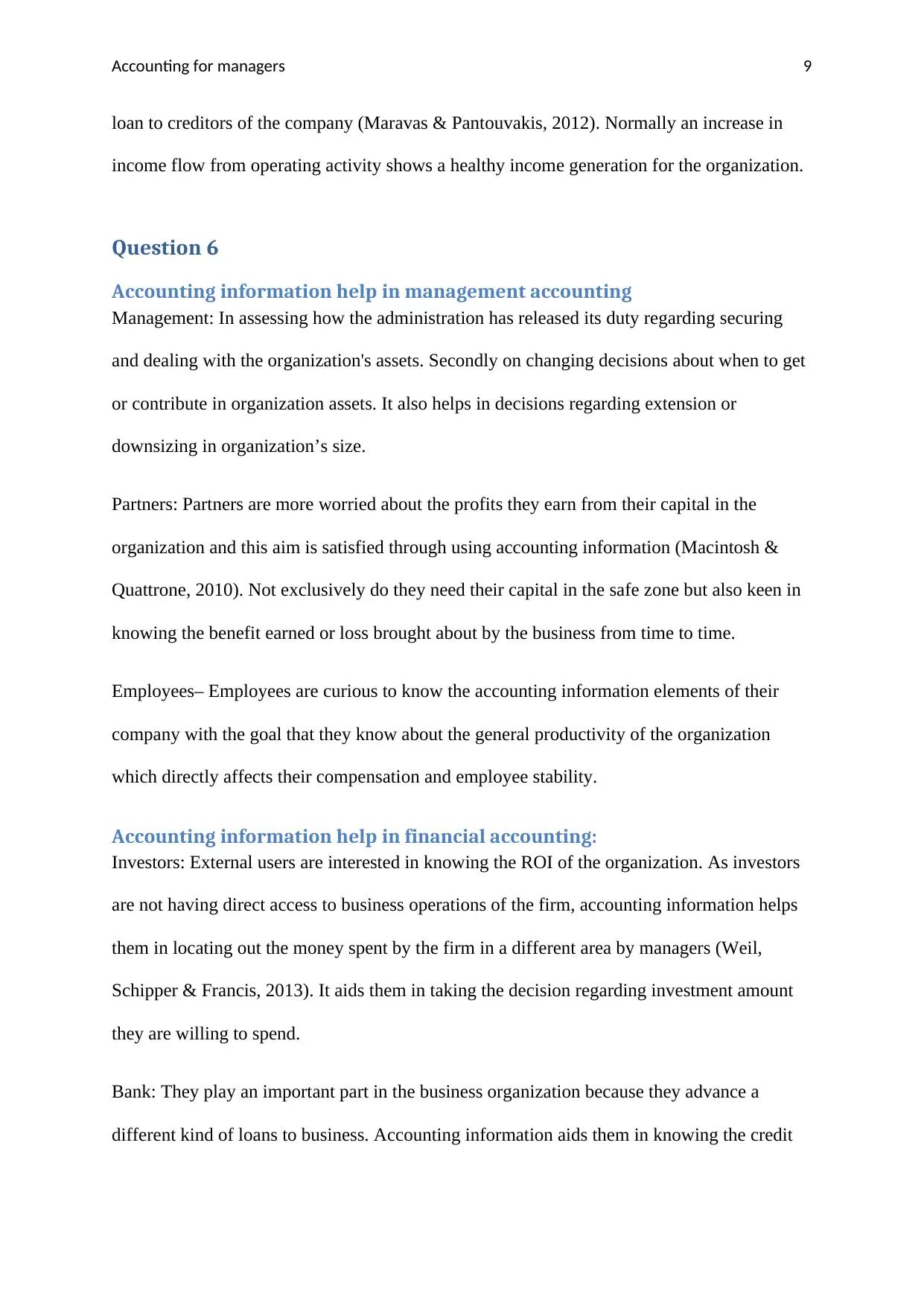
Accounting for managers 9
loan to creditors of the company (Maravas & Pantouvakis, 2012). Normally an increase in
income flow from operating activity shows a healthy income generation for the organization.
Question 6
Accounting information help in management accounting
Management: In assessing how the administration has released its duty regarding securing
and dealing with the organization's assets. Secondly on changing decisions about when to get
or contribute in organization assets. It also helps in decisions regarding extension or
downsizing in organization’s size.
Partners: Partners are more worried about the profits they earn from their capital in the
organization and this aim is satisfied through using accounting information (Macintosh &
Quattrone, 2010). Not exclusively do they need their capital in the safe zone but also keen in
knowing the benefit earned or loss brought about by the business from time to time.
Employees– Employees are curious to know the accounting information elements of their
company with the goal that they know about the general productivity of the organization
which directly affects their compensation and employee stability.
Accounting information help in financial accounting:
Investors: External users are interested in knowing the ROI of the organization. As investors
are not having direct access to business operations of the firm, accounting information helps
them in locating out the money spent by the firm in a different area by managers (Weil,
Schipper & Francis, 2013). It aids them in taking the decision regarding investment amount
they are willing to spend.
Bank: They play an important part in the business organization because they advance a
different kind of loans to business. Accounting information aids them in knowing the credit
loan to creditors of the company (Maravas & Pantouvakis, 2012). Normally an increase in
income flow from operating activity shows a healthy income generation for the organization.
Question 6
Accounting information help in management accounting
Management: In assessing how the administration has released its duty regarding securing
and dealing with the organization's assets. Secondly on changing decisions about when to get
or contribute in organization assets. It also helps in decisions regarding extension or
downsizing in organization’s size.
Partners: Partners are more worried about the profits they earn from their capital in the
organization and this aim is satisfied through using accounting information (Macintosh &
Quattrone, 2010). Not exclusively do they need their capital in the safe zone but also keen in
knowing the benefit earned or loss brought about by the business from time to time.
Employees– Employees are curious to know the accounting information elements of their
company with the goal that they know about the general productivity of the organization
which directly affects their compensation and employee stability.
Accounting information help in financial accounting:
Investors: External users are interested in knowing the ROI of the organization. As investors
are not having direct access to business operations of the firm, accounting information helps
them in locating out the money spent by the firm in a different area by managers (Weil,
Schipper & Francis, 2013). It aids them in taking the decision regarding investment amount
they are willing to spend.
Bank: They play an important part in the business organization because they advance a
different kind of loans to business. Accounting information aids them in knowing the credit
⊘ This is a preview!⊘
Do you want full access?
Subscribe today to unlock all pages.

Trusted by 1+ million students worldwide
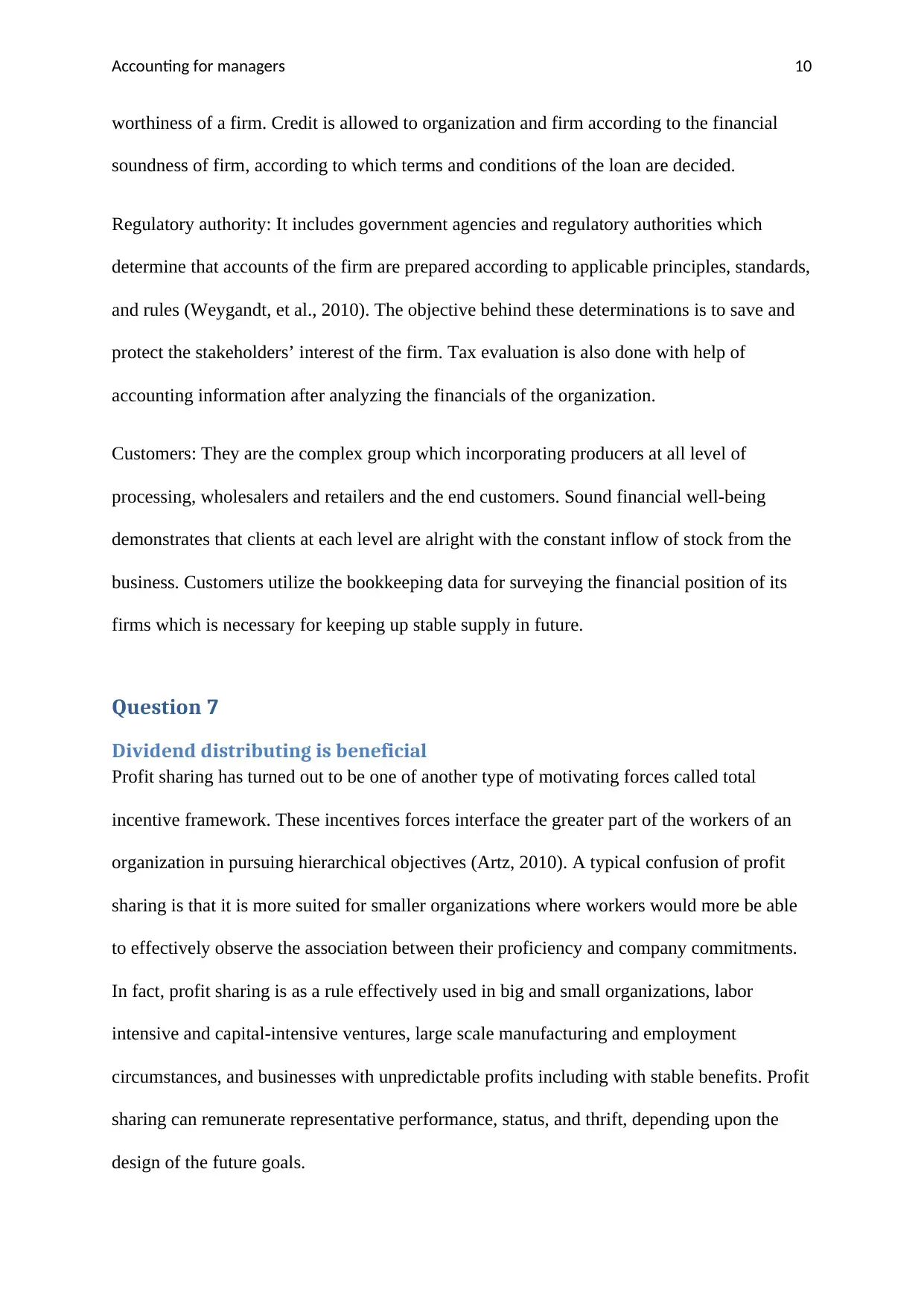
Accounting for managers 10
worthiness of a firm. Credit is allowed to organization and firm according to the financial
soundness of firm, according to which terms and conditions of the loan are decided.
Regulatory authority: It includes government agencies and regulatory authorities which
determine that accounts of the firm are prepared according to applicable principles, standards,
and rules (Weygandt, et al., 2010). The objective behind these determinations is to save and
protect the stakeholders’ interest of the firm. Tax evaluation is also done with help of
accounting information after analyzing the financials of the organization.
Customers: They are the complex group which incorporating producers at all level of
processing, wholesalers and retailers and the end customers. Sound financial well-being
demonstrates that clients at each level are alright with the constant inflow of stock from the
business. Customers utilize the bookkeeping data for surveying the financial position of its
firms which is necessary for keeping up stable supply in future.
Question 7
Dividend distributing is beneficial
Profit sharing has turned out to be one of another type of motivating forces called total
incentive framework. These incentives forces interface the greater part of the workers of an
organization in pursuing hierarchical objectives (Artz, 2010). A typical confusion of profit
sharing is that it is more suited for smaller organizations where workers would more be able
to effectively observe the association between their proficiency and company commitments.
In fact, profit sharing is as a rule effectively used in big and small organizations, labor
intensive and capital-intensive ventures, large scale manufacturing and employment
circumstances, and businesses with unpredictable profits including with stable benefits. Profit
sharing can remunerate representative performance, status, and thrift, depending upon the
design of the future goals.
worthiness of a firm. Credit is allowed to organization and firm according to the financial
soundness of firm, according to which terms and conditions of the loan are decided.
Regulatory authority: It includes government agencies and regulatory authorities which
determine that accounts of the firm are prepared according to applicable principles, standards,
and rules (Weygandt, et al., 2010). The objective behind these determinations is to save and
protect the stakeholders’ interest of the firm. Tax evaluation is also done with help of
accounting information after analyzing the financials of the organization.
Customers: They are the complex group which incorporating producers at all level of
processing, wholesalers and retailers and the end customers. Sound financial well-being
demonstrates that clients at each level are alright with the constant inflow of stock from the
business. Customers utilize the bookkeeping data for surveying the financial position of its
firms which is necessary for keeping up stable supply in future.
Question 7
Dividend distributing is beneficial
Profit sharing has turned out to be one of another type of motivating forces called total
incentive framework. These incentives forces interface the greater part of the workers of an
organization in pursuing hierarchical objectives (Artz, 2010). A typical confusion of profit
sharing is that it is more suited for smaller organizations where workers would more be able
to effectively observe the association between their proficiency and company commitments.
In fact, profit sharing is as a rule effectively used in big and small organizations, labor
intensive and capital-intensive ventures, large scale manufacturing and employment
circumstances, and businesses with unpredictable profits including with stable benefits. Profit
sharing can remunerate representative performance, status, and thrift, depending upon the
design of the future goals.
Paraphrase This Document
Need a fresh take? Get an instant paraphrase of this document with our AI Paraphraser
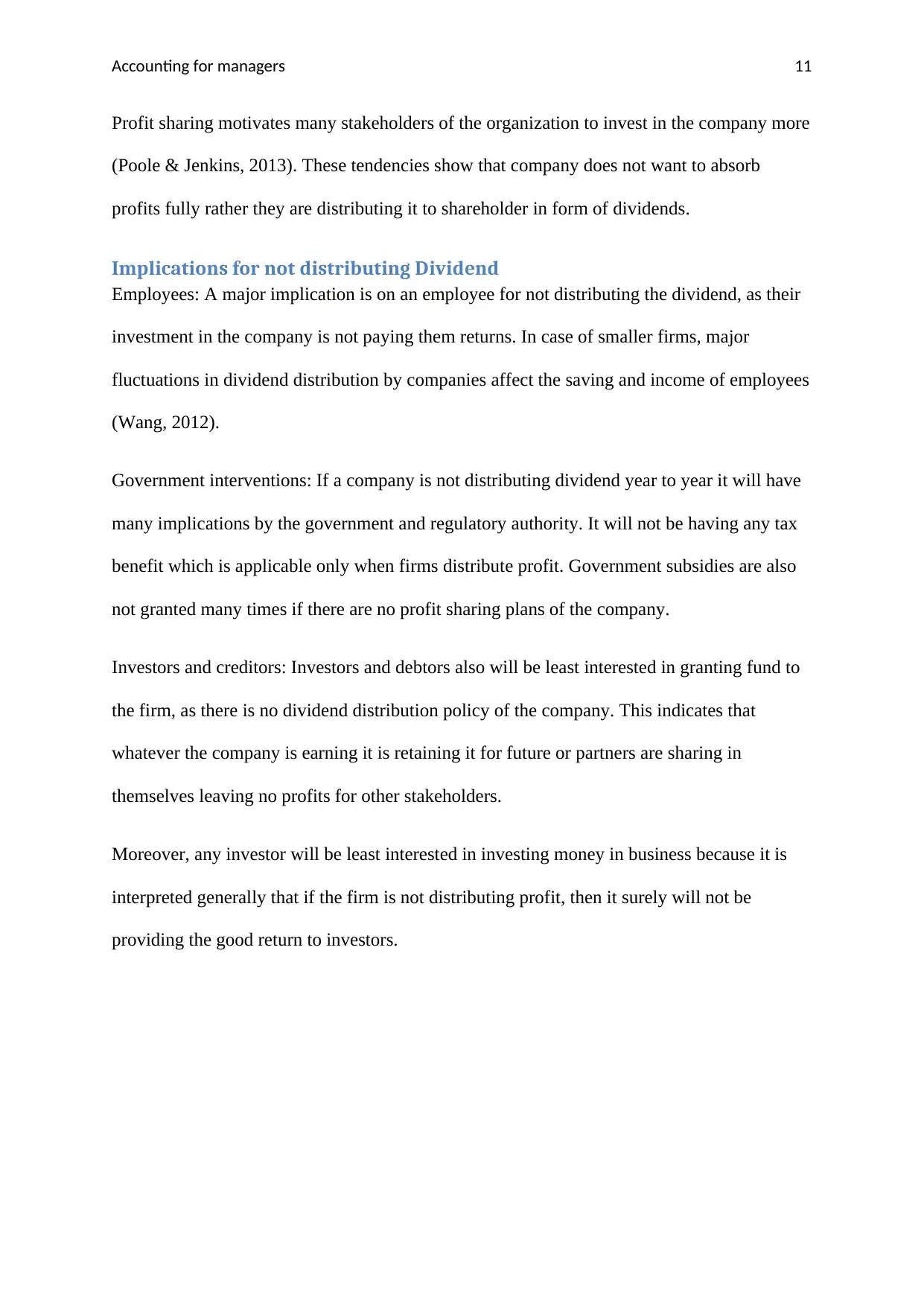
Accounting for managers 11
Profit sharing motivates many stakeholders of the organization to invest in the company more
(Poole & Jenkins, 2013). These tendencies show that company does not want to absorb
profits fully rather they are distributing it to shareholder in form of dividends.
Implications for not distributing Dividend
Employees: A major implication is on an employee for not distributing the dividend, as their
investment in the company is not paying them returns. In case of smaller firms, major
fluctuations in dividend distribution by companies affect the saving and income of employees
(Wang, 2012).
Government interventions: If a company is not distributing dividend year to year it will have
many implications by the government and regulatory authority. It will not be having any tax
benefit which is applicable only when firms distribute profit. Government subsidies are also
not granted many times if there are no profit sharing plans of the company.
Investors and creditors: Investors and debtors also will be least interested in granting fund to
the firm, as there is no dividend distribution policy of the company. This indicates that
whatever the company is earning it is retaining it for future or partners are sharing in
themselves leaving no profits for other stakeholders.
Moreover, any investor will be least interested in investing money in business because it is
interpreted generally that if the firm is not distributing profit, then it surely will not be
providing the good return to investors.
Profit sharing motivates many stakeholders of the organization to invest in the company more
(Poole & Jenkins, 2013). These tendencies show that company does not want to absorb
profits fully rather they are distributing it to shareholder in form of dividends.
Implications for not distributing Dividend
Employees: A major implication is on an employee for not distributing the dividend, as their
investment in the company is not paying them returns. In case of smaller firms, major
fluctuations in dividend distribution by companies affect the saving and income of employees
(Wang, 2012).
Government interventions: If a company is not distributing dividend year to year it will have
many implications by the government and regulatory authority. It will not be having any tax
benefit which is applicable only when firms distribute profit. Government subsidies are also
not granted many times if there are no profit sharing plans of the company.
Investors and creditors: Investors and debtors also will be least interested in granting fund to
the firm, as there is no dividend distribution policy of the company. This indicates that
whatever the company is earning it is retaining it for future or partners are sharing in
themselves leaving no profits for other stakeholders.
Moreover, any investor will be least interested in investing money in business because it is
interpreted generally that if the firm is not distributing profit, then it surely will not be
providing the good return to investors.
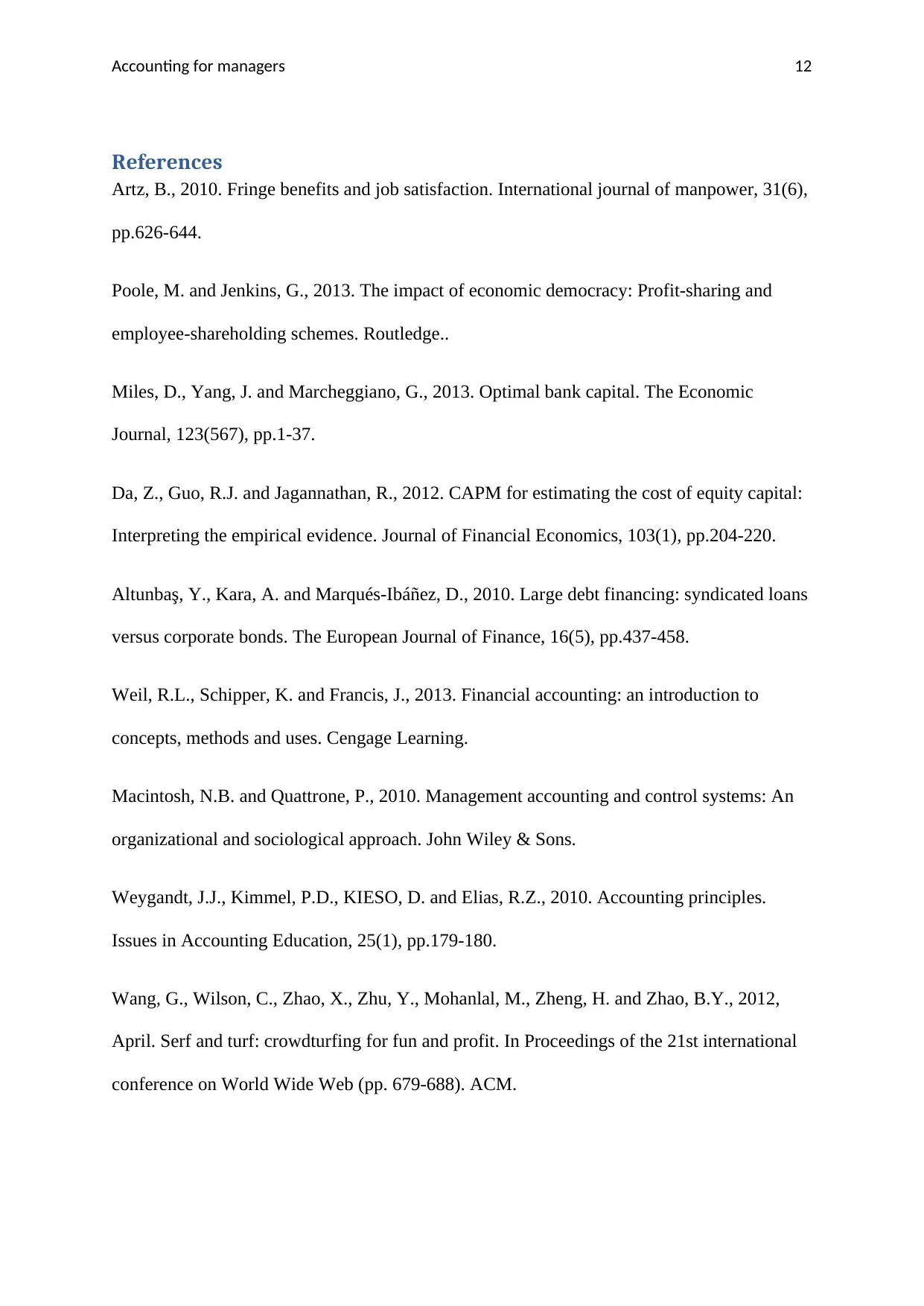
Accounting for managers 12
References
Artz, B., 2010. Fringe benefits and job satisfaction. International journal of manpower, 31(6),
pp.626-644.
Poole, M. and Jenkins, G., 2013. The impact of economic democracy: Profit-sharing and
employee-shareholding schemes. Routledge..
Miles, D., Yang, J. and Marcheggiano, G., 2013. Optimal bank capital. The Economic
Journal, 123(567), pp.1-37.
Da, Z., Guo, R.J. and Jagannathan, R., 2012. CAPM for estimating the cost of equity capital:
Interpreting the empirical evidence. Journal of Financial Economics, 103(1), pp.204-220.
Altunbaş, Y., Kara, A. and Marqués-Ibáñez, D., 2010. Large debt financing: syndicated loans
versus corporate bonds. The European Journal of Finance, 16(5), pp.437-458.
Weil, R.L., Schipper, K. and Francis, J., 2013. Financial accounting: an introduction to
concepts, methods and uses. Cengage Learning.
Macintosh, N.B. and Quattrone, P., 2010. Management accounting and control systems: An
organizational and sociological approach. John Wiley & Sons.
Weygandt, J.J., Kimmel, P.D., KIESO, D. and Elias, R.Z., 2010. Accounting principles.
Issues in Accounting Education, 25(1), pp.179-180.
Wang, G., Wilson, C., Zhao, X., Zhu, Y., Mohanlal, M., Zheng, H. and Zhao, B.Y., 2012,
April. Serf and turf: crowdturfing for fun and profit. In Proceedings of the 21st international
conference on World Wide Web (pp. 679-688). ACM.
References
Artz, B., 2010. Fringe benefits and job satisfaction. International journal of manpower, 31(6),
pp.626-644.
Poole, M. and Jenkins, G., 2013. The impact of economic democracy: Profit-sharing and
employee-shareholding schemes. Routledge..
Miles, D., Yang, J. and Marcheggiano, G., 2013. Optimal bank capital. The Economic
Journal, 123(567), pp.1-37.
Da, Z., Guo, R.J. and Jagannathan, R., 2012. CAPM for estimating the cost of equity capital:
Interpreting the empirical evidence. Journal of Financial Economics, 103(1), pp.204-220.
Altunbaş, Y., Kara, A. and Marqués-Ibáñez, D., 2010. Large debt financing: syndicated loans
versus corporate bonds. The European Journal of Finance, 16(5), pp.437-458.
Weil, R.L., Schipper, K. and Francis, J., 2013. Financial accounting: an introduction to
concepts, methods and uses. Cengage Learning.
Macintosh, N.B. and Quattrone, P., 2010. Management accounting and control systems: An
organizational and sociological approach. John Wiley & Sons.
Weygandt, J.J., Kimmel, P.D., KIESO, D. and Elias, R.Z., 2010. Accounting principles.
Issues in Accounting Education, 25(1), pp.179-180.
Wang, G., Wilson, C., Zhao, X., Zhu, Y., Mohanlal, M., Zheng, H. and Zhao, B.Y., 2012,
April. Serf and turf: crowdturfing for fun and profit. In Proceedings of the 21st international
conference on World Wide Web (pp. 679-688). ACM.
⊘ This is a preview!⊘
Do you want full access?
Subscribe today to unlock all pages.

Trusted by 1+ million students worldwide
1 out of 13
Related Documents
Your All-in-One AI-Powered Toolkit for Academic Success.
+13062052269
info@desklib.com
Available 24*7 on WhatsApp / Email
![[object Object]](/_next/static/media/star-bottom.7253800d.svg)
Unlock your academic potential
Copyright © 2020–2025 A2Z Services. All Rights Reserved. Developed and managed by ZUCOL.





